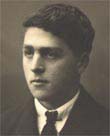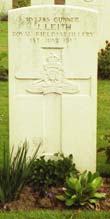In Memory ofJOHN LEITHGunner
|
|
Additional Information: Click on images to view details
|
Son of the late John and Mrs. Jane Leith, of Piperwell, Duncanston, brother of James Leith John Leith, Farmer in Courtieston, Leslie
d 28/8/1904 age 43. Wife Jane Mair d Newbigging, Inverurie 3/2/1953
age 88. Interred Leslie Kirkyard, sons recorded on headstone. Born Kennethmont, enlisted Aberdeen, killed in action, served France & Flanders. He is also listed on Leslie War Memorial. PRO :War & Victory Medals KIA - Army Returns Service Notes Divisions had Brigades of artillery in
support and in general the Artillery Brigade consisted of A,
B, C and D Batteries. A,B and C were usually 18 Pdr Field Gun
Batteries. D was usually a 60 Pdr Howitzer Battery. The really heavy guns were operated by
The Royal Garrison Artillery. |
Commemorative Information
| Cemetery: | RAILWAY DUGOUTS BURIAL GROUND, ZILLEBEKE, Ieper, West-Vlaanderen, Belgium |
| IV.
B. 9. |
|
|
Location: |
Railway Dugouts Burial Ground (Transport
Farm) is located 2 kilometres south-east of Ieper town centre, on
the Komenseweg, a road connecting Ieper to Komen (N336). From Ieper
town centre the Komenseweg is located via the Rijselsestraat, through
the Rijselpoort (Lille Gate) and crossing the Ieper ring road, towards
Armentieres and Lille. The road name then changes to Rijselseweg.
1 kilometre along the Rijselseweg lies the left hand turning onto
Komenseweg. The cemetery itself is located 1.2 kilometres along
the Komenseweg on the right hand side of the road. |
| Historical Information: | At 2 kilometres west of the village of Zillebeke the railway runs on an embankment, overlooking a small farmstead known to the British Army as Transport Farm. It is a place screened by slightly rising ground to the East, and burials on the site of the cemetery began in April, 1915. They were continued until the Armistice, especially in 1916 and 1917, when Advanced Dressing Stations were placed in the Dugouts and the farm. They were made in small groups, without any definite arrangement; and in the summer of 1917 a considerable number were obliterated by shell fire before they could be marked. The names "Railway Dugouts" and "Transport Farm" were used indifferently, and both are included in the present name. At the time of the Armistice, 1,705 graves were known and marked. Other graves were then brought in from the battlefields and small cemeteries in the neighbourhoods, and 258 known graves, destroyed by artillery fire, were specially commemorated. The latter were mainly in the present Plots IV and VII. There are now nearly 2,500, 1914-18 war casualties commemorated in this site. Of these, over 400 are unidentified and 261 are represented by special memorials. Other speical memorials record the names of 42 soldiers from Canada and 30 from the United Kingdom, buried in other cemeteries, whose graves were destroyed in later fighting. The cemetery covers an area of 16,374 square metres and is enclosed by a rubble wall, except where it borders the pond. VALLEY COTTAGES CEMETERY, ZILLEBEKE, was among a group of cottages on "Observatory Road", which runs Eastward from Zillebeke village. It contained the graves of 111 soldiers from the United Kingdom and Canada. It was in an exposed position during the greater part of the war, and of the graves in it are represented by special memorials in Railway Dugouts Burial Ground. TRANSPORT FARM ANNEXE was about 90 metres South-East of the Railway Dugouts Cemetery, on the road to Verbrandenmolen. The graves in it were removed to Perth Cemetery (China Wall), Zillebeke; but one officer, whose grave was not found, is specially commemorated here. |


